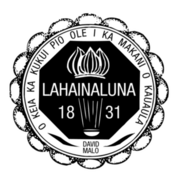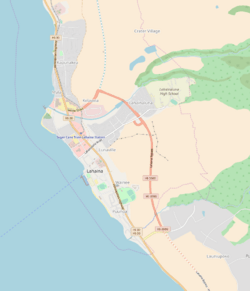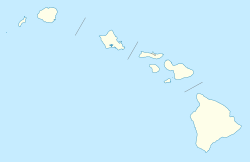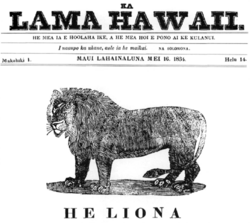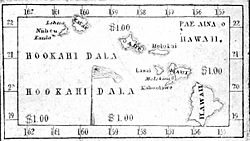Lahainaluna High School facts for kids
Lahainaluna High School is a public high school for students in grades 9 through 12. It is located in Lahaina on the island of Maui, Hawaii. This school is special because it is also a public boarding school. This means some students live there while they study.
Lahainaluna High School was started in 1831. It began as a school run by missionaries, called Lahainaluna Seminary. Missionaries came to Lahaina in 1823. They told the Hawaiian Royalty that having an American-style school was very important. Many of the first students and teachers are buried in a small graveyard on the campus. It was the first formal school in Hawaii built in the European-American style. It has been open ever since.
Contents
School History and Traditions
How Lahainaluna Began
An American named William Richards set up a missionary station in Lahaina in 1823. In June 1831, Lorrin Andrews became the first principal. He led a school for boys and young men. The school was named Lahainaluna, which means "upper Lahaina."
Classes started on September 5, 1831. They were held in simple thatched huts. There were 25 young Hawaiian men as students. One famous early student was David Malo, who was a royal historian. Later, William Patterson Alexander was the principal from 1843 to 1856. The school eventually became part of Hawaii's public school system. Its advanced programs later helped create the first University of Hawaii.
The Boarding Program
Lahainaluna has a unique boarding program. Students from other islands or even other parts of Maui can live and study at the school. They stay in dorms on campus. In return, they help out around the school. They do jobs like taking care of the grounds, looking after farm animals, and helping make meals. They work about 18 hours each week.
At first, only boys could join the boarding program. But in 1980, it became open to both boys and girls. The boys live in the David Malo Dormitory. The girls live in the Hoapili Dormitory. Lahainaluna is one of only a few public boarding schools in the United States.
The Famous "L" on the Mountain
There is a giant "L" that is 30 feet tall on the mountain above Lahaina. It is about 2,000 feet up. This "L" stands for Lahainaluna and has been there since 1904. Twice a year, the boarding students hike up the mountain. They carry 50-pound bags of white lime. They clear weeds and clean the area. Then, they put a fresh coat of lime on the "L" on Pu'u Pa'u Pa'u.
They also add the current year and any athletic championships won. On a clear day, you can see the freshly whitened "L" all the way from the island of Molokai. Lime is used because it is natural and safe for the environment. After finishing the "L", students place fresh leis at David Malo's grave. They also chant, sing, and pray there.
On graduation day, alumni (former students) hike up to the "L". They light torches that line the "L". This symbolizes that the graduates have received their diplomas.
David Malo Day
The school celebrates David Malo Day every year. On this day, a big feast is served. The Hawaiiana Club, a school club, puts on a special performance.
Super Bowl Connection
Members of the Lahainaluna High School football team and their coaches took part in the coin toss ceremony at Super Bowl LVIII. This happened after the 2023 Hawaii wildfires caused a lot of damage in Lahaina.
Hale Paʻi: The House of Printing
|
Hale Paʻi
|
|

Hale Paʻi
|
|
| Location | Lahainaluna High School, Lahainaluna, Hawaii |
|---|---|
| Area | Less than one acre |
| Built | 1834 |
| NRHP reference No. | 76000662 |
| Significant dates | |
| Added to NRHP | May 13, 1976 |
Hale Pa'i means "house of printing." It is a small building made of coral and timber on the Lahainaluna campus. Starting in 1834, it was home to Hawaii's very first printing press.
Many important things were printed here. These included Bibles, books, and newspapers in both English and the Hawaiian language. The first newspaper printed west of the Rocky Mountains was made here. In 1843, Hawaii's first paper money was also printed at Hale Pa'i.
In 1844, a student was expelled for making fake money. Because of this, the government had to re-issue all the paper money with secret marks. Today, Hale Pa'i is a museum. It is cared for by the Lahaina Restoration Foundation. You can see many old publications there. Hale Pa'i is also known as Hawaii Site No. 50-03-1596. It was added to the National Register of Historic Places in 1976.
The School Campus
Lahainaluna High School is built on the side of an old, inactive volcano. The school has many classroom buildings spread out across the campus. The grounds are covered with benches, pathways, grass, plants, and trees. The trees provide lots of shade.
A ceramic sculpture called Orbit by Toshiko Takaezu is also on campus. A small stream runs near the school, past the agriculture area. Lahainaluna is high enough on the volcano to offer amazing views. You can see the Pacific Ocean and the islands of Moloka'i, Lana'i, and Kaho'olawe.
The school also has its boarding facility. This program welcomes students from the United States and other countries. Girls live in the Hoapili Dormitory. Boys live in the David Malo Dormitory.
Notable Alumni
Many successful people have graduated from Lahainaluna High School. Here are a few:
- Timothy Haʻalilio, Class of 1835 – A Native Hawaiian politician.
- William Kahaiali'i, Class of 1979 – A famous Hawaiian music artist.
- Samuel Kamakau, Class of 1837 – A Native Hawaiian historian and scholar.
- Jonah Kapena, Class of 1835 – Another Native Hawaiian politician.
- Boaz Mahune, Class of 1835 – A Native Hawaiian politician.
- David Malo, Class of 1835 – A Native Hawaiian scholar and advisor to the royal family.
- Jonatana Napela – A Native Hawaiian attorney and judge. He helped translate the Book of Mormon into the Hawaiian language.
- Keali'i Reichel, Class of 1980 – A well-known Hawaiian music artist.
- Hercules Mata'afa, Class of 2014 – An NFL football player. He was named the Polynesian College Football Player of the Year in 2017. He plays for the Minnesota Vikings.
School Clubs and Organizations
Lahainaluna High School offers many clubs for students to join:
- Academy of Hospitality and Tourism – This club is also a business class. Students learn about the tourism industry. They practice for job interviews, do job shadowing, and internships. They also travel to different places.
- Anime Club – A fun club where students who love anime can meet and share their interests.
- Aloha Club – This club focuses on helping the community through service projects.
- Hawaiiana Club – Students in this club learn traditional hula dances. They perform these dances during the annual David Malo Day celebration.
- Interact Club – This club also does community service projects. Their projects often have an international focus.
- Japanese Club – Students in this club learn about the culture of Japan. They explore both traditional and modern Japanese customs.
- Chess Club – A casual club where students can play games of chess together.
- Water Polo Club – This club is for both boys and girls who enjoy water polo and swimming.
- Robotics Club – An after-school club that builds robots. They compete in FIRST Robotics Competition and VEX Robotics events. Students also help younger students at Princess Nahienaena elementary school learn about robotics.
See also
- Betsey Stockton
- List of boarding schools in the United States


